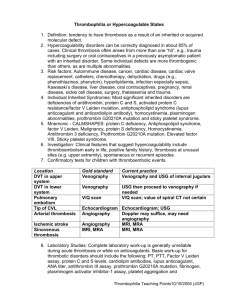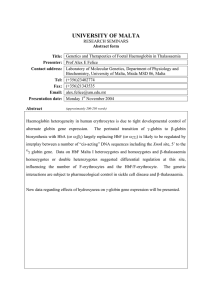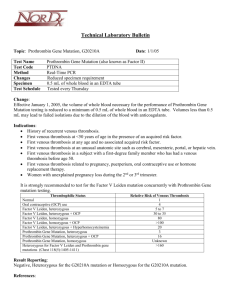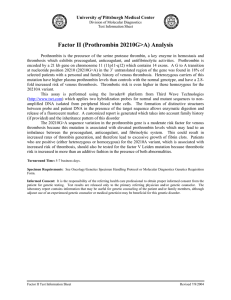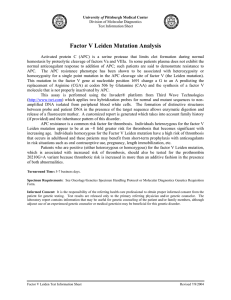Comparative Frequency of Coagulation Factor II and Coagulation Factor V Alleles
advertisement
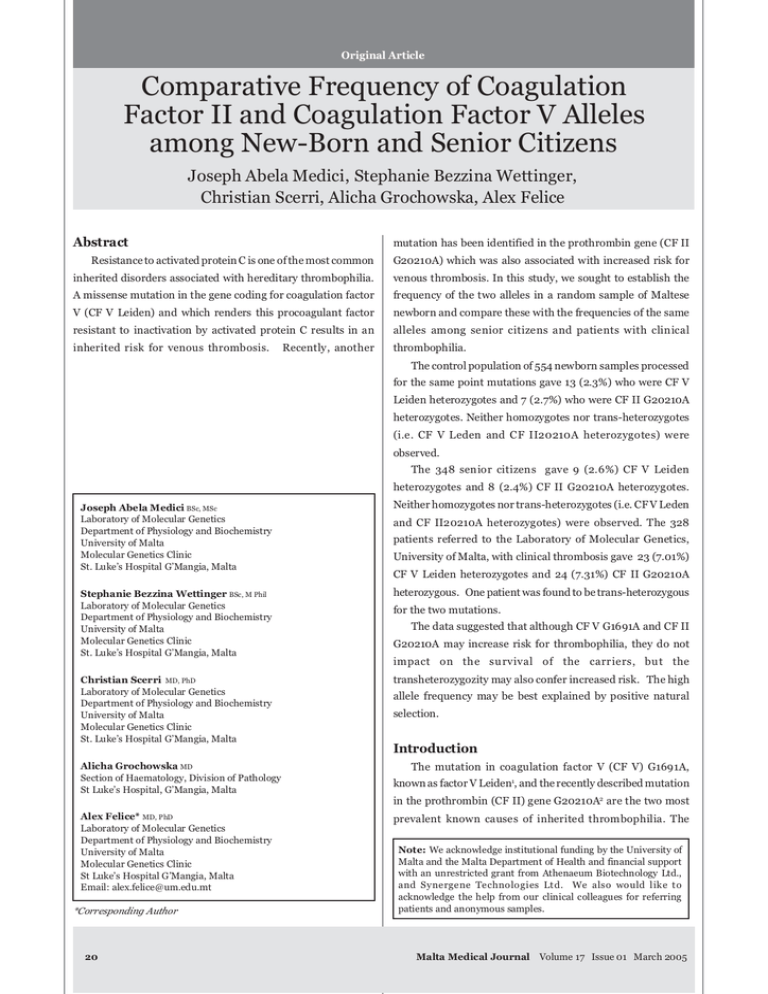
Original Article Comparative Frequency of Coagulation Factor II and Coagulation Factor V Alleles among New-Born and Senior Citizens Joseph Abela Medici, Stephanie Bezzina Wettinger, Christian Scerri, Alicha Grochowska, Alex Felice Abstract mutation has been identified in the prothrombin gene (CF II Resistance to activated protein C is one of the most common G20210A) which was also associated with increased risk for inherited disorders associated with hereditary thrombophilia. venous thrombosis. In this study, we sought to establish the A missense mutation in the gene coding for coagulation factor frequency of the two alleles in a random sample of Maltese V (CF V Leiden) and which renders this procoagulant factor newborn and compare these with the frequencies of the same resistant to inactivation by activated protein C results in an alleles among senior citizens and patients with clinical inherited risk for venous thrombosis. thrombophilia. Recently, another The control population of 554 newborn samples processed for the same point mutations gave 13 (2.3%) who were CF V Leiden heterozygotes and 7 (2.7%) who were CF II G20210A heterozygotes. Neither homozygotes nor trans-heterozygotes (i.e. CF V Leden and CF II20210A heterozygotes) were observed. The 348 senior citizens gave 9 (2.6%) CF V Leiden heterozygotes and 8 (2.4%) CF II G20210A heterozygotes. Joseph Abela Medici BSc, MSc Laboratory of Molecular Genetics Department of Physiology and Biochemistry University of Malta Molecular Genetics Clinic St. Luke’s Hospital G’Mangia, Malta Neither homozygotes nor trans-heterozygotes (i.e. CF V Leden Stephanie Bezzina Wettinger BSc, M Phil Laboratory of Molecular Genetics Department of Physiology and Biochemistry University of Malta Molecular Genetics Clinic St. Luke’s Hospital G’Mangia, Malta heterozygous. One patient was found to be trans-heterozygous Christian Scerri MD, PhD Laboratory of Molecular Genetics Department of Physiology and Biochemistry University of Malta Molecular Genetics Clinic St. Luke’s Hospital G’Mangia, Malta transheterozygozity may also confer increased risk. The high Alicha Grochowska MD Section of Haematology, Division of Pathology St Luke’s Hospital, G’Mangia, Malta and CF II20210A heterozygotes) were observed. The 328 patients referred to the Laboratory of Molecular Genetics, University of Malta, with clinical thrombosis gave 23 (7.01%) CF V Leiden heterozygotes and 24 (7.31%) CF II G20210A for the two mutations. The data suggested that although CF V G1691A and CF II G20210A may increase risk for thrombophilia, they do not impact on the survival of the carriers, but the allele frequency may be best explained by positive natural selection. Introduction The mutation in coagulation factor V (CF V) G1691A, known as factor V Leiden1, and the recently described mutation in the prothrombin (CF II) gene G20210A2 are the two most Alex Felice* MD, PhD Laboratory of Molecular Genetics Department of Physiology and Biochemistry University of Malta Molecular Genetics Clinic St Luke’s Hospital G’Mangia, Malta Email: alex.felice@um.edu.mt *Corresponding Author 20 prevalent known causes of inherited thrombophilia. The Note: We acknowledge institutional funding by the University of Malta and the Malta Department of Health and financial support with an unrestricted grant from Athenaeum Biotechnology Ltd., and Synergene Technologies Ltd. We also would like to acknowledge the help from our clinical colleagues for referring patients and anonymous samples. Malta Medical Journal Volume 17 Issue 01 March 2005 impaired neutralization of thrombin or a failure to control the mutation frequency shows a marked increase from 1.7% in the generation of thrombin increases the risk of clinical North to 3% in the South. 11 3 thrombosis. Since inherited hypercoagulability is a persistent, Both these mutations can be co-inherited (trans- lifelong condition, whereas thrombosis occurs only heterozygotes) leading to much increased risk of thrombosis episodically, one might argue that all thrombotic events must possibly manifesting in younger patients and having increased be precipitated by an acquired thrombogenic trigger. In many severity. cases, the transient risk factor is clinically apparent (e.g., the In this study we report the comparative frequencies of the postoperative state, immobilization, or the peripartum period). CF V Leiden and CF II G20210A alleles in a number of random In others, in which thrombosis is considered to be idiopathic, newborn, a number of senior citizens and patients referred for the acquired trigger is probably a sub clinical thrombogenic investigation of clinical thrombotic episodes. The data showed stimulus. Thus,many cases of venous thrombosis may involve that although there was no significant difference in frequencies the convergence of one or more inherited prothrombotic between the newborn and the senior citizens, thus excluding mutations (leading to alifelong state of hypercoagulability) and effects on survival, a much higher frequency was found among an acquired thrombogenic insult that precipitates the actual the patients with thrombosis. clinical event.4 In patients with relatively low base-line degrees of hypercoagulability (e.g., those without any, or with a single Materials and Methods mutation, such as CF V Leiden), a major, clinically clear The study was approved by the Research Ethics Review stimulus would be required to trigger the thrombotic episode. Board of the Faculty of Medicine of the University of Malta. In contrast, patients with higher base-line degrees of The blood samples were collected by venipuncture in EDTA hypercoagulability (e.g., those with multiple mutations in the vacutainers (Becton Dickinson Vacutainer Systems, UK) coagulation pathway) would require only relatively minor, anonymised and stored at a temperature of -20∞C in a locked often subclinical, acquired insults to precipitate thrombosis. freezer. Blood was collected from random senior citizens (348) In haemostasis, CF V is activated by thrombin when the referred through the Haematology Department from the latter is produced by the action of CF Xa on prothrombin (CF outpatients clinic at St. Luke’s Hospital, Gwardamangia, Malta. II); CF Va then acts as a cofactor of CF Xa and together they Umbilical cord blood samples (554) were collected daily from 2+ associate with Ca on the phospholipid surface of platelets or the maternity ward at St. Luke’s Hospital and patients (328) endothelia to form an active “prothrombinase” that converts were referred for investigation in connection with clinical additional prothrombin to thrombin.5 CF Va catalyses the rate thrombosis. 6 of CF Xa mediated prothrombin activation by a 1,000 fold. CF Va is inactivated by activated protein C thus limiting Genetic Analysis thrombin formation from prothrombinase. However, the CF DNA extraction was performed using the Nucleon!” BACC1 V G1691A mutant resists inactivation leading to excess Kit (Amersham Life Science). DNA analysis for the 1691 G to 6 thrombin generation and predisposition to thrombosis. CF A substitution in the CF V gene was conducted by restriction V Leiden is a common mutation in Caucasians, with a endonuclease digestion of a polymerase chain reaction (PCR) heterozygote frequency ranging from 2% to 15% in several product as described by Bertina et al (1994; Figure 1). 7,8 populations. However, it also shows important regional Restriction endonuclease digestion of the CF V PCR product differences ranging from 2% in South Europe to 16% in parts with Mnl 1 resulted in three fragments of 22bp, 37bp and 116bp of North Europe.7 The risk of thrombosis is increased sevenfold (Figure 1). In the presence of the A at 1691(CF V Leiden), one in heterozygotes and 80-fold in homozygotes as compared with of the recognition sites is blocked and the enzyme cuts only 9 non carriers. In Southeast Asia and Africa the frequency of once resulting in two fragments of 22bp and 153bp. Analysis the mutation is less than 1%.7 of the 20210 G to A substitution in the 3’-untranslated region The CF II G20210A mutation has also been associated with 2 of the prothrombin gene was conducted by restriction increased prothrombin levels in the plasma. The thrombosis endonuclease digestion of the corresponding PCR product as risk is increased by two when plasma CF II levels exceed 115% described by Poort et al (1996; Figure 2). The CF II PCR was of normal.2,10 carried out using a mutagenised reverse primer 5’-ATA GCA The frequency of the prothrombin variant in 11 Caucasian populations is about 2%. Within Europe the Malta Medical Journal Volume 17 Issue 01 March 2005 CTG GGA GCA TTG AAG C-3’ where the underlined adenosine 23 base is absent from the wild type sequence. The primer together with the G20210A point mutation of CF II, created a 2 Coagulation Factor II CF II restriction endonuclease digestion yielded 7 GA HindIII recognition site. The undigested CF II PCR product heterozygotes (2.7%) and no abnormal homozygotes among was 345bp long. In the presence of the G20210A point the newborn population and 8 GA heterozygotes (2.4%) and mutation, the CF II PCR product had one HindIII recognition no abnormal homozygotes among the senior citizens. No site resulting into two fragments, one of 322bp and one of 23bp significant difference was observed between these two in length (Figure 2). populations. CF II restriction endonuclease digestion among the referred patients yielded 24 GA heterozygotes (7.3%) and Statistical Analysis no abnormal homozygotes. The referred population The data were analysed statistically by the Hardy-Weinberg frequencies were found to be significantly different when Equilibrium, Fisher Exact test, Chi Square Contingency test compared to the frequencies found in the senior citizen and Odds Ratio. population (Table I). One trans-heterozygote was also found among them. Results All data are summarised in Table I Discussion We have shown here that, somewhat contrary to Coagulation Factor V expectations, the allele frequency of the CF II G20210A and CF V restriction endonuclease digestion yielded 13 GA the CF V G1691A, although high were practically the same heterozygotes (2.3%) and no abnormal homozygotes among among the random newborn and the senior citizens in our the newborn population and 9 GA heterozygotes (2.6%) and study. Although both alleles increase the risk of thrombosis, no abnormal homozygotes among the senior citizen population. as shown by the finding of even higher frequencies (0.035 and No significant difference was observed between these two 0.037) among the patients with a variety of clinical thrombosis populations. CF V restriction endonuclease digestion among and the studies of others 9-11, the relatively high frequency the referred patients yielded 23 GA heterozygotes (7.0%) and should imply a positive element of natural selection, although no abnormal homozygotes. The referred population founder effects and genetic drift cannot be formally excluded. frequencies were found to be significantly different when The high frequency of haemolytic anaemia due to compared to the frequencies found in the random newborn haemogobinopathy and G6PD deficiency among populations and the senior citizens (Table I). from geographic areas endemic for malaria12 or, possibly other intra-erythrocytic parasites such as Leishmania, and, of Cystic Fibrosis with respect to diarrhoeal virus13 are good examples of positive natural selection. Figure 1 : Above: Mnl1 restriction map of CF V PCR product Below: Separation of MnlI digested PCR products on 8% PAGE. Lane 1 = PhiX/Hae III, lane 2 – 8 = homozygote GG, lane 9 = heterozygote GA, lane 10 = undigested product. 24 One may assume that in the Figure 2: Above: HindIII restriction map of CF II PCR product Below: Separation of HindIII digested PCR products on 6% PAGE. Lane 1 = PhiX/Hae III, lane 2 – 12 = homozygote GG, lane 13 = undigested product, lane 10 = heterozygote GA. Malta Medical Journal Volume 17 Issue 01 March 2005 Table 1: Genotype distribution and allele frequencies of CF V Leiden and CF II G20210A in Senior Citizens, Control Cords and Referred Samples. The results of the statistical analysis are given for every mutation. Bold result means statistical significance. A) Based on genetic analysis of random Maltese cord samples (24) pooled together with recent cord analysis of 285 cord in CF V Leiden and 126 cords in CF II. B) Based on genetic analysis of patient samples that are referred to the Laboratory of Molecular Genetics for thrombosis analysis C) P- Value is greater than 0.05, the null hypothesis is accepted i.e. there is no significant difference between the frequencies in Senior Citizens and the other group under study. D) For significant difference at the 0.05 level, chi-square should be greater than or equal to 3.84. The null hypothesis is accepted, i.e. the frequencies do not differ. E) An OR > 1 indicates that there might be an association between the genotype and the phenotype or medical disorder. Malta Medical Journal Volume 17 Issue 01 March 2005 25 migration of humans out of Africa into Northern Europe either patients with sickle cell disease from less resourced countries the CF II G20210A or the CF V G1691A carrier could have where health care is poor. We could not show any difference survived traumatic or obstetric bleeding better than their wild among the patients from North America with appropriate type travellers. Recently, it has been shown that the CF V health care.26 Leiden heterozygotes preferentially survived severe sepsis and There is a reciprocal North-South gradient in the relative a similar observation was made on a mouse model of frequency of the CF II G20210A and CFV G1691A alleles. It endotoxaemia. 14 Thus, natural selection appears a more appears that because of the higher risk of the trans- satisfactory and patho-physiologically sound explanation than heterozygotes and homozygotes the higher frequency of one drift or founder effects. Based on our prior observation on the allele could keep the other down. Geographic gradients have , we had also been seen in beta-Thalassaemia with the b + (Beta positive) anticipated a lower frequency of one or both thrombogenic IVS-1, 6C thalassaemia being commoner in the Western alleles among the older subjects assuming that fatal thrombosis Mediterranean and the b + (Beta positive) IVS-I , 110A would have decreased the number of surviving heterozygotes, thalassaemia being commoner in the Eastern Mediterranean 27. homozygotes and trans-heterozygotes. In Cystic Fibrosis the CFTR; DF508 mutation frequency is population distribution of CF VII frameworks 15, 16 The modern view of haemostasis places the CV VII-tissue increased in the North and declines in the South except in Malta factor complex in a critical step for initiation and amplification and the Basque region of Spain.28 The geographic epidemiology of thrombosis. We15, 16 and others17-21 showed that the of alleles may well reflect the outcome of evolutionary pressures production of CF VIIa is genetically regulated due to two on human migration, which resulted in contemporary alternate forms of the CF VII gene with one being more active genomes. than the other. The allele frequency of the slower variant, CF These data strongly confirm the pathophysiologic risk of VII Framework II in Shinawi et al 16 is found more frequently thrombosis due to hypercoagulability among CF V G1619A, CF among the older sector of the population. Presumably, they II G20210A heterozygotes and trans-heterozygotes. However, may have been protected from the “hypercoaguable” state by the two mutations do not appear to influence mortality from the slow variant. In this study, however, the results showed the clinical events. no significant difference between the control newborn conduct prospective clinical follow up among CF V G1619A, population and the senior citizens population, implying that and CF II G20210A carriers conditioned on their CF VII the frequencies of both the CF V Leiden and the CF II G20210A genotype and the response to therapeutic procedures. In future studies it would be useful to alleles did not change with age and thus did not reflect the References occurrence of fatal outcomes. Similarly the frequency of the HFE allele of hereditary haemochromatosis has been found higher among the elderly in Sicily compared to younger subjects.22-24 Clearly, there must be many other alleles of many other genes whose enrichment 1. Bertina RM, Koeleman BP, Koster T, Rosendaal FR, Dirven RJ, de Ronde H et al. Mutation in blood coagulation factor V associated with resistance to activated protein C. Nature 1994; 369(6475):64-67. 2. Poort SR, Rosendaal FR, Reitsma PH, Bertina RM. A common among senior citizens compared to neonates, or vice versa, genetic variation in the 3'-untranslated region of the prothrom- provides an efficient tool for the discovery of “patho- bin gene is associated with elevated plasma prothrombin levels and an increase in venous thrombosis. Blood 1996; 88(10):3698- physiologically meaningful sequence variation” in man. 3703. Thus, unlike CF VII frameworks, the CF II G20210A and CF V G1691A alleles did not appear to increase the risk of fatal thrombosis. Alternatively the current level of healthcare in Europe compensates for the additional risk. The interplay between alpha Thalassaemia and Hb S homozygotes (sickle cell disease) provides grounds for comparison. 25,26 A concurrent alpha thalassaemia modifies the developmental haematology of sickle cell disease with alpha plus thalassaemia homozygotes having a much milder anaemia. A higher frequency of alpha Thalassaemia can be found among older 26 3. Seligsohn U, Lubetsky A. Genetic susceptibility to venous thrombosis. N Engl J Med 2001; 344(16):1222-1231. 4. Schafer A.I. Molecular mechanisms of hypercoagulable states. Austin, Tex.: Landes Bioscience, 1997. 5. Israels LG, Israels ED. Mechanisims in Hematology. 2nd Edition ed. England: Core Health Sciences Inc., 1996. 6. Simioni P. The molecular genetics of familial venous thrombosis. Baillieres Best Pract Res Clin Haematol 1999; 12(3):479-503. 7. Rees DC, Cox M, Clegg JB. World distribution of factor V Leiden. Lancet 1995; 346(8983):1133-1134. 8. Tosetto A, Missiaglia E, Gatto E, Rodeghiero F. The VITA project: phenotypic resistance to activated protein C and FV Malta Medical Journal Volume 17 Issue 01 March 2005 Leiden mutation in the general population. Vicenza Thrombo- 20. Kang W, Wang H, Xiong L, Wang X, Chu H, Qu B et al. Study on philia and Atherosclerosis. Thromb Haemost 1997; 78(2):859- plasma coagulation factor VII (FVII) levels and polymorphisms 863. of FVII gene in patients with coronary heart disease. Zhonghua 9. Rosendaal FR, Koster T, Vandenbroucke JP, Reitsma PH. High Xue Ye Xue Za Zhi 2002; 23(9):457-459. risk of thrombosis in patients homozygous for factor V Leiden 21. Toso R, Pinotti M, High KA, Pollak ES, Bernardi F. A frequent (activated protein C resistance). Blood 1995; 85(6):1504-1508. human coagulation Factor VII mutation (A294V, c152) in loop 10. Marz W, Nauck M, Wieland H. The molecular mechanisms of inherited thrombophilia. Z Kardiol 2000; 89(7):575-586. 11. Rosendaal FR, Doggen CJ, Zivelin A, Arruda VR, Aiach M, 140s affects the interaction with activators, tissue factor and substrates. Biochem J 2002; 363(Pt 2):411-416. 22. Candore G, Balistreri CR, Lio D, Mantovani V, Colonna-Romano Siscovick DS et al. Geographic distribution of the 20210 G to A G, Chiappelli M et al. Association between HFE mutations and prothrombin variant. Thromb Haemost 1998; 79(4):706-708. acute myocardial infarction: a study in patients from Northern 12 .Ruwando C, Khea SC, Snow R. W, Yates S N R, Kwiatkoweld D, Gupta S, Warn P, Alisopp GEM, Gilbert S C, Peschu N, Newbold C I, Greenwood S M, Marsh K, Hill A V S. Natural selection of hemi- and heterozygotes for G6PD deficiency in Africa by resistance to severe malaria. Nature 376: 246-249. 1995; 13. The European Working Group on CF Genetics; Gradient of Distribution in Europe of the Major CF Mutation and of its Associated Haplotype. Hum. Genet. 85, 436 - 445, 1990. 14. Kerlin BA, Betty Yan S, Iserman BH, Brandt JT, Sood R, Basson and Southern Italy. Blood Cells Mol Dis 2003; 31(1):57-62. 23. Candore G, Mantovani V, Balistreri CR, Lio D, Colonna-Romano G, Cerreta V et al. Frequency of the HFE Gene Mutations in Five Italian Populations. Blood Cells Mol Dis 2002; 29(3):267-273. 24. Lio D, Balistreri CR, Colonna-Romano G, Motta M, Franceschi C, Malaguarnera M et al. Association between the MHC class I gene HFE polymorphisms and longevity: a study in Sicilian population. Genes Immun 2002; 3(1):20-24. 25. Campo S, Restuccia T, Villari D, Raffa G, Cucinotta D, Squadrito BR et al. Survival advantage associated with heterzygous factor G et al. Analysis of haemochromatosis gene mutations in a V Leiden mutation in patients with severe sepsis and in mouse population from the Mediterranean Basin. Liver 2001; endotoxemia. Blood 2003; 102, (9): 3085 - 3092. 15. Pace J. The design and operation of a DNA bank; Molecular epidemiology of coagulation factor VII alleles. Faculty of Science, Department of Biology, University of Malta, 1997. 16. Alshinawi C, Scerri C, Galdies R, Aquilina A and Felice AE, Two 21(4):233-236. 26. Felice AE, Altay CA, Milner PF, Huisman TH. The occurrence and 0identification of alpha-thalassemia-2 among hemoglobin S heterozygotes. Am J Clin Pathol 1981; 76(1):70-73. 27. Felice AE, Webber B, Miller A, Mayson SM, Harris HF, Henson New Missense Mutations (P134T AND A244V) in the Coagula- JB et al. The association of sickle cell anemia with heterozygous tion Factor VII Gene. Human Mutation 1 - 3, 1997. and homozygous alpha-thalassemia-2: in vitro HB chain 17. Xu G, Jin G, Fu G, Ma J, Shi Y, Tang O et al. Polymorphisms in the coagulation factor VII gene and the risk of myocardial infarction in patients undergoing coronary angiography. Chin Med J (Engl ) 2003; 116(8):1194-1197. 18. Kavlie A, Hiltunen L, Rasi V, Prydz H. Two novel mutations in the human coagulation factor VII promoter. Thromb Haemost 2003; 90(2):194-205. 19. Kakko S, Elo T, Tapanainen JM, Huikuri HV, Savolainen MJ. Polymorphisms of genes affecting thrombosis and risk of synthesis. Am J Hematol 1979; 6(2):91-106. 28. Felice AE, Bezzina Wettinger S, Buhagiar S et al., Molecular Epidemiology of Haemoglobin and the Molecular Biology of in vivo Globin Gene Expression. Life Chemistry Reports 15;1: 27 36, 1997. 29. Josifiva DJ, ScerriI CA, Vassallo N, Buhagiar S, Bezzina Wettinger S, Plis S et al. Significance of Molecular Epidemiology in a Small Island population. Genetics Epidemiology 2004 (submitted). myocardial infarction. Eur J Clin Invest 2002; 32(9):643-648. Malta Medical Journal Volume 17 Issue 01 March 2005 27
